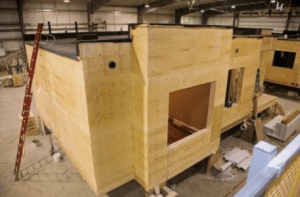THE (SURPRISINGLY LONG) HISTORY OF MODULAR CONSTRUCTION
When thinking about modular construction, many people assume that the trend started in the 20th century, but it actually dates back much further than expected. Modular construction has changed and adapted over the past three centuries and is still evolving. Read on to learn more about the history of the modular building industry.
Origins
The origins of modular buildings date back to the 1600s. One of the first reported modular homes was brought to life by a colonial American fisherman who had recently moved from England and wanted a home built with trusted English construction methods. The solution to this was to have a disassembled home shipped by boat across the Atlantic Ocean.
In the 1800s, as the United States expanded westward, modular construction began to make a more prominent appearance. During the California Gold Rush, mining towns boomed, and as they flourished, a quick housing solution was needed. More than 500 preassembled homes were built in factories in New York and then shipped across the country to California.
But it wasn't until the end of the 19th century that the demand for modular homes started trending upwards. In 1897, E.F. Hodgson opened a manufacturing plant in Dover, Massachusetts which profited from the rapidly growing American population. The E.F Hodgson Company developed a catalog from which they sold modular homes across the country. Sears, Roebuck and Montgomery Ward soon followed in their footsteps and sold hundreds of thousands of modular homes over the next few decades.
20th Century
After the development of the assembly line by Henry Ford in 1913, it became even easier to manufacture modular homes at a price that was affordable to many more consumers. And after World War II, when the US faced a housing crisis as soldiers returned home and started families, modular construction offered quick, low-cost housing options to house a new generation of Americans. From the beginning, modular buildings have provided innovative and affordable solutions.
In the years after, the modular building industry expanded from homes and into commercial projects. The benefits of modular construction became clear - it was fast, cost-effective, and infinitely customizable. Across the country, mobile homes and recreational vehicles were being converted into classrooms and mobile offices. The classic modular diner, which is instantly recognizable by it's long, narrow shape (easy to ship by train), began cropping up along the East Coast, and in particular, in New Jersey.
But it wasn't until the end of the 19th century that the demand for modular homes started trending upwards. In 1897, E.F. Hodgson opened a manufacturing plant in Dover, Massachusetts which profited from the rapidly growing American population. The E.F Hodgson Company developed a catalog from which they sold modular homes across the country. Sears, Roebuck and Montgomery Ward soon followed in their footsteps and sold hundreds of thousands of modular homes over the next few decades.
21st Century and Beyond
In recent years, the tiny house boom has breathed new life into modular buildings. Again and again, people are discovering how modular homes can be friendly for both the environment and their budget. Modular buildings have a smaller ecological footprint and can be built with durability and unique character. Today you can buy a modular house for much less than one built on-site, and you can customize nearly every aspect.
New technology, like better construction cranes, have allowed modular buildings to be built bigger, taller, and in many designs. Units can be shipped across the country and can be put together on-site in a matter of days. In fact, in 2003, a McDonald's restaurant was constructed in a record 13 hours. In the future, we can expect more and more people and businesses to embrace modular buildings for homes, offices, businesses and more.
---------------------------------
This is an online exclusive article.
